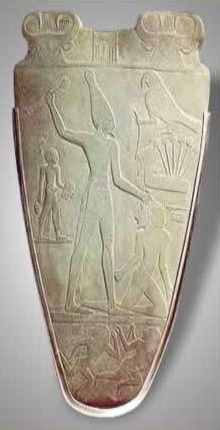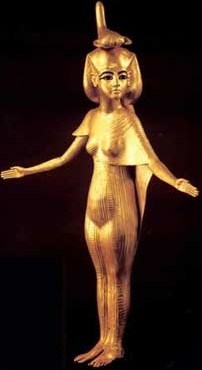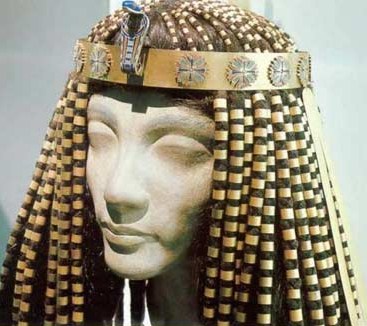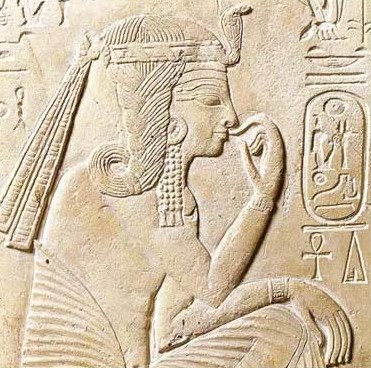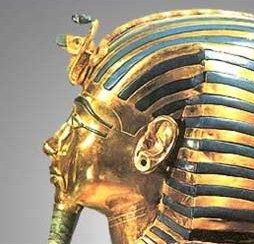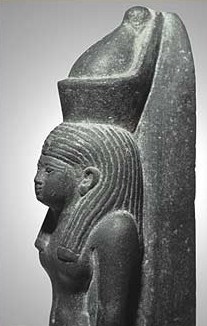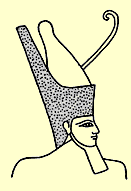 |
 |
 |
Crowns of Ancient Egypt, An Introductionby Jimmy Dunn
Many people think in terms of a having a single crown that was worn as a symbol of his office. However, in ancient Egypt, there were a number of different types of crowns, mostly worn by gods, kings and queens and sometimes their children. Sometimes, as in the case of the Red and White crowns, they could also be combined to form a special symbolism, such as in this case, the unity of Upper and Lower Egypt under one ruler. They played a dominant role in the composition of the royal and the divine image. Gods and kings were never represented without one, because they indicated important aspects of both royalty, divinity, and of Egypt itself.
According to the ancient Egyptians, and specifically the Book of the Dead, the original wearer of the crowns of Egypt was Osiris:
"Glory be to thee, O Osiris Un-Nefer, thou great god in Abtu (Abydos), King of Eternity, Lord of Everlastingness, God whose existence is millions of years, eldest son of Nut, begotten by Geb, the Ancestor-Chief, Lord of the Crowns of the South and the North, Lord of the High White Crown "
For kings, the number and variation of crowns grew over time. However, various gods were frequently associated with a single crown, such as Selket. The basic headdress of her crown did sometimes change, but almost certainly it was surmounted by a scorpion. At the same time though, because the identities of various gods were sometimes merged with others, a certain crown primarily worn by one god might also be depicted crowning another. Specifically, whether king or god, the crowns worn by them always impart upon the wearer aspects symbolized by the nature of the crown.
Form and Composition
So much of ancient Egypt has survived into this present day, but apart from circlets and kerchiefs, no real ancient Egyptian crowns have survived. hence, their actual size and the material from which they were made is uncertain, even though we do have many examples of statuary and reliefs that depict gods and royalty wearing them. As in most cultures, crowns mark the wearer as distinct from the average human being. This is usually achieved by optically "enhancing" the wearer, making him or her appear taller, and by using precious material, such as gold, silver and gemstones. Egyptian crowns are generally represented as very tall, sometimes so tall that they could hardly have been worn, and indeed, such elements as high feathers are represented in token from at a much smaller scale on some surviving royal headdresses. This fact emphasizes the emblematic significance of items of regalia, which functioned virtually as hieroglyphs, with their combinations forming "sentences" that could be read and altered by varying their constituent elements. This view is supported by cases of posthumously altered headdresses in representations of royal personae.
Royal regalia, and in particular crowns, often link their wearer with the superhuman sphere, and the height of Egyptian crowns itself points toward the heavenly or divine. Therefore, the crown of Queen Hatshepsut can be stated to "pierce the sky" during her coronation before the god Amun. Bestowed on the ruler by the gods in texts and representations, in ancient Egypt crowns symbolize the connection of earthly and divine rule. Most crowns can be said to belong to the sun god Re, or some other deity, but bestowed by them on the king. Adornment with precious materials (or their colors), in particular the shimmer of gold and silver, provides a further link with gods who are associated with radiance. Solar or stellar disks can be added to a crown-type as well as one or more cobra-form uraeus snakes, which represent the fire and blinding radiance issuing from the sun god's "eye". the solar disk, to consume potential enemies. Crowns themselves are often equated with the eyes of Re or Horus.
Typically, only one uraeus adorns the forehead of the ruler. In the Early Dynastic Period and the Old Kingdom, it appears exclusively with kerchiefs (nms) and headbands, but never on tall crowns. From the 6th Dynasty onward, royal women too may wear a uraeus. A few uraei of gold, some of them inlaid, survive from Middle and New Kingdom tombs.
The distinctive shape of the uraeus, like that of crowns in general, at different periods can provide important evidence in dating uninscribed artifacts. For example, a double uraeus, one usually wearing the Red Crown and the other the White Crown, is attested for royal women from the reign of Ahmose on. A variation is the (sometimes double) uraeus augmented by a vulture head, referring to the goddess Wadjet and Nekhbet. Another examples includes the plain Kushite cap, which is distinctive of rulers of the 25th Dynasty and their Napatean and Meroitic successors. Depending on the context, the uraeus can also bear the head of a gazelle (especially for subsidiary royal women) or an ibis. Ptolemaic queens may even wear a triple uraeus. A further increase in the number of cobras is attested from the reign of Amenhotep III on, when a kalathos of uraei as a crown base is attested. Akhenaten is the first king to display a circlet of uraei, also worn by gods, around some of his crowns. The radiance conveyed by disks and uraei likens the wearer to the gods, and the increase of their number on crowns seems to correspond with periods of intensified solar cult activity, developing in particular during he Amarna period.
Plants or parts of animals may also be incorporated into crowns, including feathers (of falcons or ostriches) and horns (of rams, cattle or gazelles). These features appear to associate the wearer with the qualities of the specific god who was manifest in a given animal. Thus, the curved ram's horn, a symbol of Amun, which occurs at the side of royal headdresses from the time of Amenhotep I, identifies the ruler with this god and imbues him with divine qualities.
Plant ornaments are confined mostly to the crowns of queens and princesses, and seem to evoke beauty and youth or rejuvenation. Exceptions are the central element of the atef-crown and the occasional presence of the ished-fruit on the same crown, and the "wire" or curl" of the Red Crown.
Religious and Political Significance.
The large number of crowns attested for a single ruler, such as Hatshepsut, with nine different types and the same number of basic headdresses, is attested in depictions from the Old Kingdom on. They reflect different aspects of kingship. The political and religious significance of crowns for the image of the king can be inferred from the fact that different headdresses were favored in different periods. Thus, some types of crown do not appear in the Amarna period, as an example. Akhenaten's queen Nefertiti wore crowns confined to the king in other periods, such as the cap crown, and new crown types were invented for her, apparently to symbolize her expanded role.
Some texts suggest a metaphorical use of the royal crowns to embody the office of kingship, or even the political or geographical notation of the kingdom. Such was the Double Crown, symbolizing the rule of both Upper and Lower Egypt.
Funerary Crowns
Funerary literature from the period of the Pyramid and Coffin Texts on provides that crowns are an important role to play int he rites of passage that transform the deceased into an inhabitant of the sky. Endowing him with divine attributes such as radiance, they both lien the dead king to the gods of the sky and impart to him authority over them. They symbolize ascent to the sky and rebirth, as is shown by representations of crowns in the object-friezes on coffins and beneath the bier, and also by the practice of placing crown-amulets on mummies. This symbolism relates to the range of meaning of the Egyptian term h'w, which can be rendered as "arisings" and "manifestations", as well as "crowns". The same root is used in the term of accession to the throne. Crowns were also used in the temple ritual evoking the rebirth of deities, and crown models are known to have been kept in temple crypts.
See also: Resources:
|


